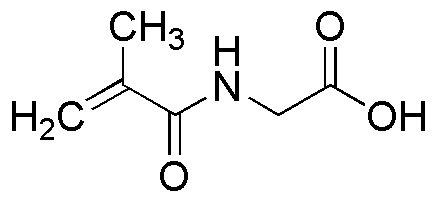N-Methacryloylglycine is widely utilized in research focused on:
- Polymer Chemistry: It serves as a key monomer in the synthesis of hydrogels and other polymeric materials, enhancing the mechanical properties and biocompatibility of the final products.
- Biomedical Applications: This compound is used in drug delivery systems, where its ability to form hydrogels allows for controlled release of therapeutic agents, improving treatment efficacy.
- Coatings and Adhesives: N-Methacryloylglycine is incorporated into coatings to provide improved adhesion and durability, making it valuable in industries such as automotive and construction.
- Cosmetic Formulations: Its properties are leveraged in skincare products to create films that enhance moisture retention and provide a smooth texture, appealing to cosmetic manufacturers.
- Analytical Chemistry: It is utilized in the development of sensors and analytical devices due to its ability to interact with various biomolecules, aiding in the detection of specific substances.
General Information
Properties
Safety and Regulations
Applications
N-Methacryloylglycine is widely utilized in research focused on:
- Polymer Chemistry: It serves as a key monomer in the synthesis of hydrogels and other polymeric materials, enhancing the mechanical properties and biocompatibility of the final products.
- Biomedical Applications: This compound is used in drug delivery systems, where its ability to form hydrogels allows for controlled release of therapeutic agents, improving treatment efficacy.
- Coatings and Adhesives: N-Methacryloylglycine is incorporated into coatings to provide improved adhesion and durability, making it valuable in industries such as automotive and construction.
- Cosmetic Formulations: Its properties are leveraged in skincare products to create films that enhance moisture retention and provide a smooth texture, appealing to cosmetic manufacturers.
- Analytical Chemistry: It is utilized in the development of sensors and analytical devices due to its ability to interact with various biomolecules, aiding in the detection of specific substances.
Documents
Safety Data Sheets (SDS)
The SDS provides comprehensive safety information on handling, storage, and disposal of the product.
Product Specification (PS)
The PS provides a comprehensive breakdown of the product’s properties, including chemical composition, physical state, purity, and storage requirements. It also details acceptable quality ranges and the product's intended applications.
Certificates of Analysis (COA)
Search for Certificates of Analysis (COA) by entering the products Lot Number. Lot and Batch Numbers can be found on a product’s label following the words ‘Lot’ or ‘Batch’.
*Catalog Number
*Lot Number
Certificates Of Origin (COO)
This COO confirms the country where the product was manufactured, and also details the materials and components used in it and whether it is derived from natural, synthetic, or other specific sources. This certificate may be required for customs, trade, and regulatory compliance.
*Catalog Number
*Lot Number
Safety Data Sheets (SDS)
The SDS provides comprehensive safety information on handling, storage, and disposal of the product.
DownloadProduct Specification (PS)
The PS provides a comprehensive breakdown of the product’s properties, including chemical composition, physical state, purity, and storage requirements. It also details acceptable quality ranges and the product's intended applications.
DownloadCertificates of Analysis (COA)
Search for Certificates of Analysis (COA) by entering the products Lot Number. Lot and Batch Numbers can be found on a product’s label following the words ‘Lot’ or ‘Batch’.
*Catalog Number
*Lot Number
Certificates Of Origin (COO)
This COO confirms the country where the product was manufactured, and also details the materials and components used in it and whether it is derived from natural, synthetic, or other specific sources. This certificate may be required for customs, trade, and regulatory compliance.


